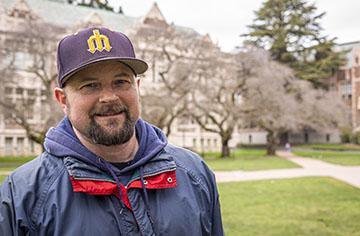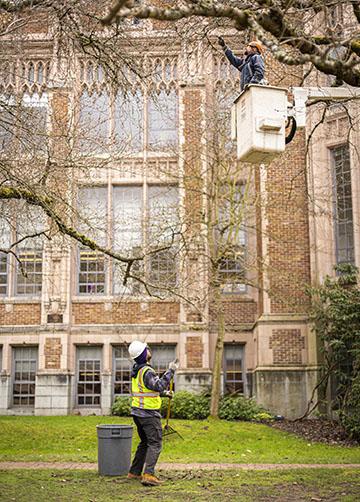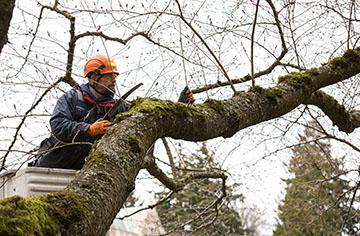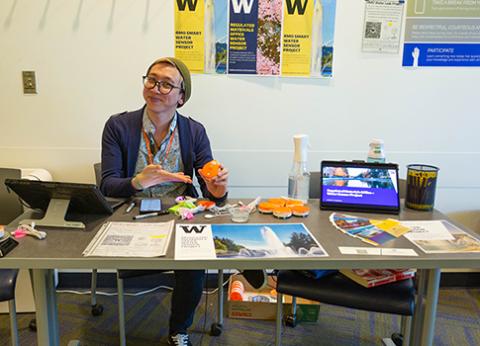The art of caring for UW’s cherry trees
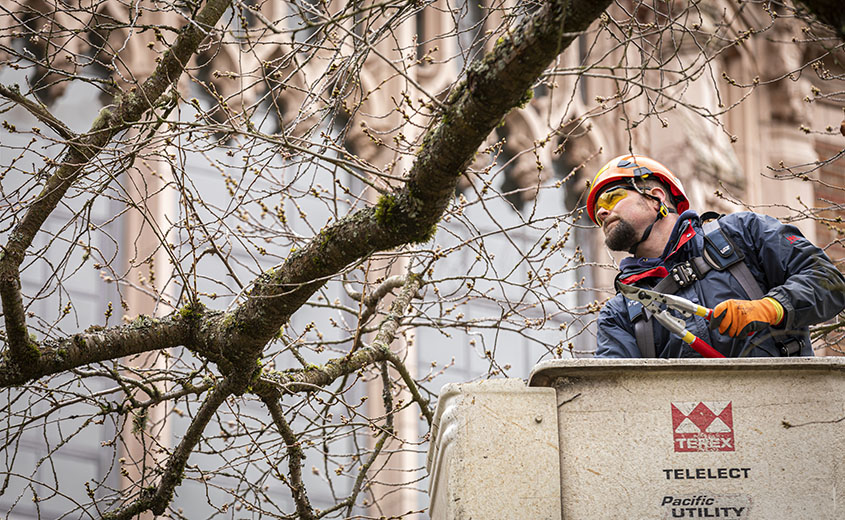
Lead gardener Chris Holmer examines a cherry tree in UW's Quad. He's selective when choosing which branches to prune.
A lot has changed on the UW campus over the years. New buildings go up, old buildings get renovated and light rail tunnels down below. One thing remains constant: The cherry trees in the Quad bloom every March.
The UW’s cherry tree blossoms have been campus symbols since 1965, attracting crowds and media attention, but it wasn’t always clear how long they would endure. In March 1999, the UW alumni magazine ran an article titled, “Time is running out on Quad’s signature cherry trees.”
“I think they're kind of magical,” said Chris Holmer, the lead gardener working on the trees. “They're not in the healthiest situation for them to grow. But every year, they bloom and they look beautiful.”
Holmer started as a UW gardener in 2000, when he took what was supposed to be a break from college to support his wife, who was in graduate school. He planned to go back, but he liked the hours, which allowed him to meet his kids at the bus after school.
And he liked the work. He found he could make a visible difference working with the mature landscape and plant diversity on central campus — a duty he calls a “privilege.” In 2008, Holmer became the lead gardener for his area, the borders of which include PACCAR Hall, the HUB, Suzzallo Library, and the Music and Art buildings on the north end of the Quad.
When he started, Holmer said there were rumors that the cherry trees would need to be removed within 10 years.
Tunnels run underneath the Quad to distribute steam, chilled water and electricity across campus. They turn the area into what Holmer calls a “sink” and “huge planter” with poor drainage, evidenced by the pools of water that form when there’s heavy rain. The poor drainage makes the trees susceptible to a fungal infection called brown rot.
The cherry trees are also vulnerable to the cherry bark tortrix, a pest that lays its larvae in and then saps nutrients from fruit trees.
Replacement trees were grown at a nursery in Mount Vernon, Washington. But when they reached maturity, the Quad’s trees were still doing well, so the replacements were planted elsewhere on campus.
The cherry trees have lasted due to a combination of longevity and hard work.
Holmer said that older trees are better able to withstand the stress caused by brown rot. One tree was removed in 2018, but it was one of the younger trees, planted in 2001. The trees are also treated yearly for pest infestation.
When Holmer started as lead gardener, he removed 25 to 35 truckloads of deadwood from the trees. Now every year, his team, which includes gardeners Kai Bachiller and Liam Flynn, prunes deadwood twice a week, from January through March, and then prunes live wood in July and August. They prune for aesthetics but also to make sure the branches have access to light and room to grow.
Holmer and his team leave a lot of interior growth on the trees, waiting until the right time to prune the small growths emerging from the trunk and branches. For Holmer, it’s all about timing and a long-term plan: small branches today may provide scaffolding in the future.
This technique creates a whirling effect visible when standing at the bottom of a tree and looking up. First, you see the blooms emerging from tiny shoots on the trunk, then from smaller branches and then from the canopy up above.
These decisions are part of what Holmer calls the “dance” of gardening and caring for the cherry trees. Gardeners follow a schedule, but following too closely can mean moving forward even when there’s a cold snap or if conditions change.
Instead, Holmer said, you should listen to nature.
“I think when I started, the way I went about my job was 80% physical and 20% mental, and now it’s flipped,” he said. “It's not all about just bulldozing your way through the day. It's about feeling the energy of the plants and everything around you and trying to be part of that. And not control it — just get over that. There are so many life lessons there.”
For Holmer, gardening is an art. It may not have been what he set out to do as a career in 2000, but once he started doing it, he didn’t want to do anything else.
“It's been therapy, just for dealing with emotions,” Holmer said. “I’m no good at drawing but I'm pretty good at seeing and designing and working in landscape. I can see that I can prune and tweak things a little bit and where to draw it out.
“It's like we're always working on a painting or a canvas that you just keep adding and taking stuff away from — and it's so beautiful.”
For more information on UW’s cherry blossoms, including visitor information, tree safety and more, go to uw.edu/cherryblossoms.
